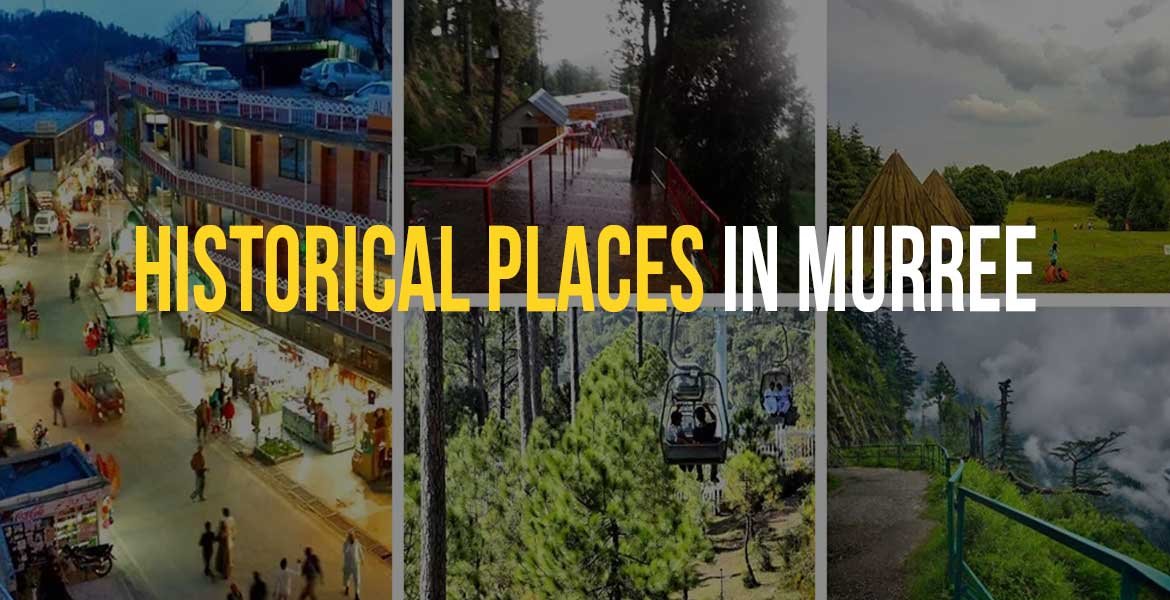Murree is historically known as “Queen of the hills,” and this is a beautiful place to visit. Muree was built by the British council as a summer vacation spot in the mid-1800s, but because of its mesmerizing beautiful places, it has quickly become a center for colonial government, education, and fun. British commanders who were fleeing the plains enjoyed its lush hills, pleasant climate, and good location. There are many historical places in Murree. Its winding streets and hazy hills are full of history. Big churches, private boarding schools, quiet cemeteries, and historic military residences made the town appealing.
Top Historical Places in Murree
1. Holy Trinity Church
Murree’s Mall Road Holy Trinity Church is a prominent colonial building, and it is one of the important historical places in Murree. The Holy Trinity church, Murree, was built in 1857–1875. Building so that British Indians might worship in their churches was the main motive. Stained glass windows, pointed arches, and solid stone walls define Victorian Gothic churches. The aged pews and wooden doors make me think of the 1800s. The calm atmosphere and historical things inside depict Murree’s colonial heritage.
If you appreciate history, you have to tour Holy Trinity Church in Murree. It is a place to pray and a method to remember the town’s British past, Lawrence College, Ghora Gali. Lawrence College is a British remnant that is located in the tranquil Ghora Gali area of Murree. The college was founded in 1860 by Sir Henry Montgomery Lawrence to educate British soldier orphans. It then became a top Pakistani boarding school.
The college’s historic architecture survives on 150 acres of pine-covered hills. Original stone buildings, groomed lawns, and a large assembly hall evoke ancient English boarding schools. The institution has produced numerous respected military, civil, and intellectual professionals in Pakistan for over 160 years. Along with its architecture, its culture and traditions have preserved its historic appeal. Everything on campus—from stone paths to the antique clock tower—tells a narrative of the past.
Lawrence College is essential for Murree history buffs. The school is visible from Ghora Gali Road and is worth seeing for its history and education, even while it is closed. A remarkable blend of academic excellence and imperial tradition.
2. Murree General Post Office (GPO)
Another prominent British building in Murree is the 1867 GPO. Strategically located at the start of Mall Road, it was the colonial administration and military’s principal communication hub in the highlands. It was built in rustic colonial style. A red-brick front, sloped roofs, and arched windows. GPO handles Murree’s mail and courier services despite its age.
The Murree GPO (General Post Office) was more than a post office during British rule, connecting outlying officers and officials in the highlands to administrative headquarters across India. It enabled telegram services, essential for government and military coordination.
Tourism and history fans will find the GPO convenient and fascinating, revealing colonial administration infrastructure. The building symbolizes how the British updated Murree while preserving its architecture. This site shows how profoundly these institutions were incorporated into colonial life, deepening your research of Murree’s history.
3. Mall Road, Murree
Murree is centered on Mall Road, yet its history runs deep. The British upper class built Mall Road during colonial times as a place to walk, shop, and hang out at night. Cecil Hotel and beautiful British bungalows offer a peek of the past amid modern delights.
Mall Road has seen Murree go from colonial summer capital to tourist destination. Old cobblestone roads, the GPO, and neighboring churches like the Holy Trinity still elicit nostalgia despite modernization.
Combining old and new, modern businesses in vintage structures make shopping here distinctive. Cafés and restaurants in the area have a colonial feel. No history tour is complete without a walk on Mall Road, Murree. Where history meets daily living, every building has a narrative and every turn unlocks a colonial Murree chapter.
4. St. Denys’ Church, Murree Hills
St. Denys’ Church at Kashmir Point is a lesser-known but important colonial Murree landmark. It was founded in 1882 as part of Murree Hills’ Anglican school for British girls. Colonial households relied on it for worship and education.
Anglican stained glass depicts the Bible. Long oak pews, high ceilings. The old structure stands solid in Kashmir Point’s pines. St. Denys’ Church is quieter and more private than Holy Trinity Church. History buffs will enjoy its quiet setting off the main road. You must visit this church to learn about Murree’s history.
St. Denys’ Church, Murree Hills is quieter and more private than Holy Trinity Church. History buffs will enjoy its quiet setting off the main road. You must visit this church to learn about Murree’s history. The hidden charm and architectural grandeur reveal the British settlers’ lives. Colonial homes and stone pathways add historical significance.
5. Governor’s House (Punjab House), Murree
The Governor’s House (Punjab House), Murree, was constructed in 1937 following the Circuit House. Punjab governors used it as a summer hideaway after serving high-ranking British commanders. Colonial elegance and political significance are set against Murree hill views.
British architecture features stone walls, wooden interiors, and beautiful gardens. Its efficient and attractive design is typical of colonial times. It has entertained ministers and foreign visitors for decades, making it a major administrative site.
Preservationists were excited and divided when the Punjab government suggested turning this ancient building into a university campus in 2019. Though ideas are still forming, the building is a must-see for British-era legacies.
Visiting Punjab House in Murree offers political history and colonial charm. Although public access is limited, its impressive construction and historical significance make it a highlight in Murree’s changing environment.
6. Convent of Jesus and Mary, Murree
The Convent of Jesus and Mary, Murree founded by St. Claudine Thévenet in 1876, is a Murree educational and religious landmark. As a girls’ boarding school, it educated British daughters in colonial India. The intellectually and spiritually gifted Religious of Jesus and Mary ran the school and convents.
The colonial school has high brick walls, arched doorways, and large courtyards. It remains a prestigious girls’ institution with calm dignity. Famous Pakistani women have studied here, enhancing its heritage. The British community used the church and music halls for social events in addition to education. Today, the school’s annual activities continue those traditions.
The convent reveals colonial schooling and missionary organizations’ influence on Murree’s history. Despite restricted admission, the school is respected from the outside and has a strong reputation in Murree and beyond.
7. Ghora Gali
Ghora Gali, a historical place in Murree, is a short drive away. The name means “Horse Alley” in Urdu, referring to the colonial British cavalry deployed here. British officers and their families preferred Ghora Gali as a hideaway due to its mild climate and strategic location.
The neighborhood is most known for Lawrence College, although its history goes deeper. British soldiers and locals drank beer from the subcontinent’s oldest brewery, Murree. Although the brewery moved, its foundation remained.
Many Old Ghora Gali homes and churches are still in use or restored. Colonial architecture is present in local homes and public buildings. Visiting Ghora Gali is like going back in time. History buffs in Murree visit it for its tranquillity and unspoiled beauty. History is everywhere, from pine-lined avenues to museums.
8. Dunga Gali & Pipeline Track
British officers used to vacation at Dunga Gali & Pipeline Track, a hill station in Galyat. Its tranquillity and spectacular views made it a popular plains hideaway. The Pipeline Track, a peaceful walk along the former water pipeline to Murree, is its most notable feature.
Walking between Dunga Gali and Ayubia gives wonderful views of colonial rest houses, foggy slopes, and pine trees. Some of these buildings are guesthouses or cafes, but they remember the town’s British past.
Dunga Gali is wonderful due to its natural beauty and preserved colonial elements. The old British homes with sloping tin roofs, wooden balconies, and stone walkways show how people lived back then. The Pipeline Track is a peaceful and educational tour of Murree’s history and environment. It gives a one-of-a-kind experience away from the tourist spots because it has both beautiful and historical sites.
9. Old Colonial Hotels
Old Colonial Hotels (e.g., Cecil Hotel, Shangrila Resort) have entertained generations of travelers, including British officers, diplomats, and nobles, adding to Murree’s historical beauty. Luxury was at its peak at the Cecil Hotel. This late 1800s British estate has grand stairs, timber interiors, and vast verandas.
Although built later, the Shangrila Resort contains historic grounds and features historical decor. The colonial elite attended ballroom dances, elaborate dinners, and high teas at these establishments.
Many of these businesses operate with modern conveniences. Preservation of architecture and vintage furniture gives them an old-world appeal. These hotels offer colonial hospitality with blazing fireplaces and vintage decor. Visitors can experience Murree’s history at these colonial hotels. These sites still exude age-old elegance, whether for a night or tea.
10. Old British Cemeteries
A substantial British graveyard honors Murree (Gora Qabristan)’s colonial past. The 1800s and early 1900s British officers, missionaries, government officials, and their families are buried here. Each burial tells the story of soldiers who died in the winter and of diseases brought by colonists.
However neglected, these cemeteries are powerful historical places in Murree. They reveal the challenges of early colonial settlers who made Murree a hill station. Heritage groups may fix and document 1850s graves that are overgrown or ruined.
Old British Cemeteries (e.g., Gora Qabristan) are deeply affecting and historically rich sites that lend a personal dimension to colonial history, quiet places where the past is actually beneath your feet for Murree history buffs.
11. Dunga Gali British Residences
Its British-era homes make Dunga Gali British Residences stand out. These homes were summer retreats for British politicians and their families. The area’s rich pine trees and fresh mountain winds make it a great place to live in tranquillity away from the Indian plains.
These homes represent more than architecture—they show how the British moved to the hills. These little British homes had fireplaces, imported furniture, and English-style gardens. Tourists can see some of these homes when walking or driving through Dunga Gali. They enhance the region’s old-world charm and show colonial life. These surviving mansions exhibit Murree’s colonial past’s wealth and remoteness for history buffs.
Why Choose MAS Holiday Homes?
MAS Holiday Homes is suitable for guests who want to see Murree’s rich history in comfort and ease. It is convenient for visiting Mall Road, Holy Trinity Church, and Lawrence College due to their location near historical landmarks. MAS Holiday Homes is quiet and modern while fitting with the town’s historical style. All cottages are tastefully designed and offer a warm welcome and views of Murree’s pine-covered hills.
For solo heritage enthusiasts or families planning a Murree historical tour, MAS Holiday Homes guarantees a tranquil stay. Murree’s proximity to famous and lesser-known historical sites is useful for cultural travelers. The hosts also help travelers organize their schedule by recommending hidden historical sites and local restaurants with decades of history. This place makes a visit a complete historical experience.
Conclusion
Murree is a living museum of British colonial life, not just a hill station with cool weather and beautiful views. From old churches and post offices to schools and cemeteries, the town is full of antiques. The stories that defined its identity and rich cultural experience await you at these historical places in Murree.
From Holy Trinity Church to Dunga Gali’s peaceful stroll, every spot has a tale. They depict colonial ambition, architectural grandeur, and social transformation. Murree is unique in its history and hospitality for tourists and students. With MAS Holiday Homes making your stay pleasant and enjoyable, Murree should be your next heritage visit.
FAQs
Which historical sites in Murree are the greatest to visit?
Some of the best spots to visit are Holy Trinity Church, Lawrence College, Murree GPO, St. Denys’ Church, and colonial hotels like the Cecil Hotel.
Can you visit these historical locations all year long?
Most locations are open year-round; however, April–October is the optimum time due to good weather.
Which famous gali is in Murree?
A higher height gives Nathia Gali better views, trekking pathways, and colder weather than the Galyat range. From Murree, Abbottabad is 32 miles (20 km).
Where to stay near old places?
Yes, MAS Holiday Homes and other guesthouses are close to Murree’s historic landmarks, making it easy to stay there.
Are these areas safe for kids and old people to visit?
Of course. Families can enjoy most historical places in Murree, however some may need assistance.






